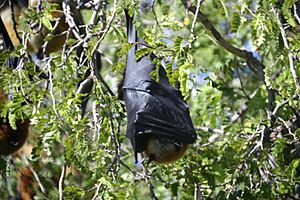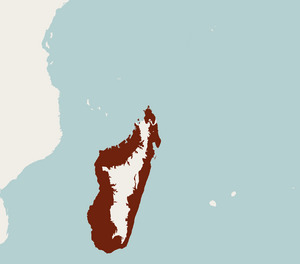Madagascan flying fox facts for kids
Quick facts for kids Madagascan flying fox |
|
|---|---|
 |
|
| Conservation status | |
| Scientific classification | |
| Genus: |
Pteropus
|
| Species: |
rufus
|
 |
|
| Madagascan flying fox range | |
The Madagascan flying fox, also known as the Madagascar fruit bat (Pteropus rufus), is a type of large bat. It lives only on the island of Madagascar. These bats are very important for their environment. They help spread seeds and pollinate flowers. You can find them in many different places, like wet lowland forests, dry forests, and even near the coast in mangrove areas.
Contents
About the Madagascan Flying Fox
What Does It Look Like?
The Madagascan flying fox is the biggest bat in Madagascar. Its body is about 23.5 to 27 centimeters (9 to 10.5 inches) long. When its wings are spread out, they can reach 100 to 125 centimeters (39 to 49 inches) wide! This bat usually weighs between 500 and 750 grams (1.1 to 1.65 pounds).
These bats have brown fur on most of their bodies. Their chest and shoulders often have a golden or slightly darker brown color. Their large wings are grey to black. Both male and female Madagascan flying foxes look very similar. However, males usually have a head that is a little bit bigger than the females.
Where Do They Live and What Do They Eat?
During the day, Madagascan flying foxes rest in large trees. They live in big groups called colonies. A colony can have up to 1,000 bats, but about 400 is more common. These bats can be quite noisy. If something disturbs them, the whole colony might fly off to a different resting spot. They often choose isolated trees in areas that have been changed by humans.
Their main food is fruit juice. They squeeze the juice from fruits in their mouths. When they do this, they often swallow many seeds. These seeds then pass through the bat's body and are dropped in new places. This helps new plants grow far from the original tree. They also eat other parts of trees, like leaves, flowers, and nectar. Scientists have seen them visiting the flowers of the kapok tree. It is believed they help pollinate these trees, which means they help the trees make new seeds.
Where Can You Find Them?
The Madagascan flying fox is one of the most common bat species on Madagascar. You can find them almost everywhere on the island. The only place they usually don't live is in the very high central mountains. They can live from sea level up to about 1,200 meters (about 3,900 feet) high.
Why Are They in Danger?
The IUCN (International Union for Conservation of Nature) has listed the Madagascan flying fox as "Vulnerable". This means their numbers seem to be going down. The biggest danger they face is being hunted for food. In Madagascar, hunting this bat is allowed only between May and August.
People hunt these bats both where they rest and where they feed. Many people believe that too many bats are being caught, which is not good for their population. They are hunted for families to eat and also to be sold. Another big threat is the loss of their homes. Forests where they live are being cut down to make space for farms.
Even though they are in danger, some Madagascan flying foxes live in protected areas. In these special places, they should be safer from hunting.


